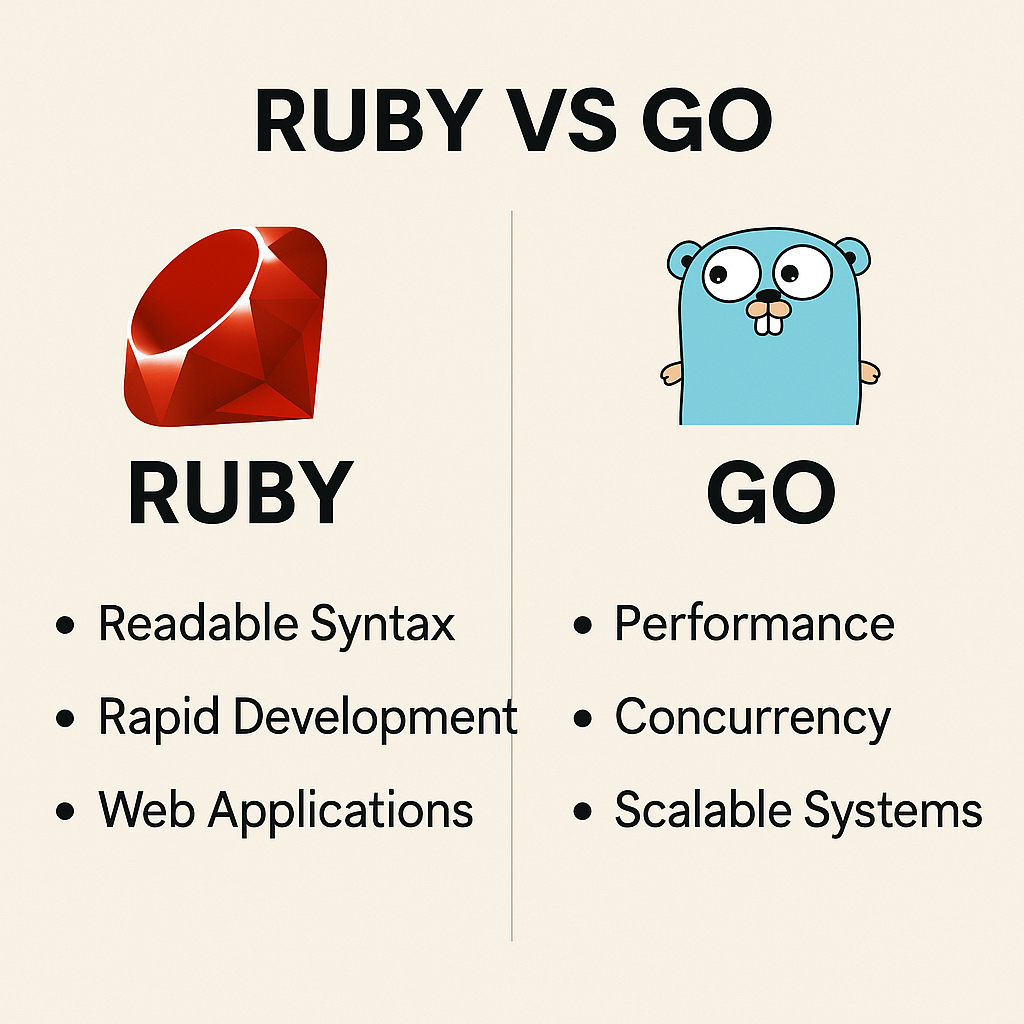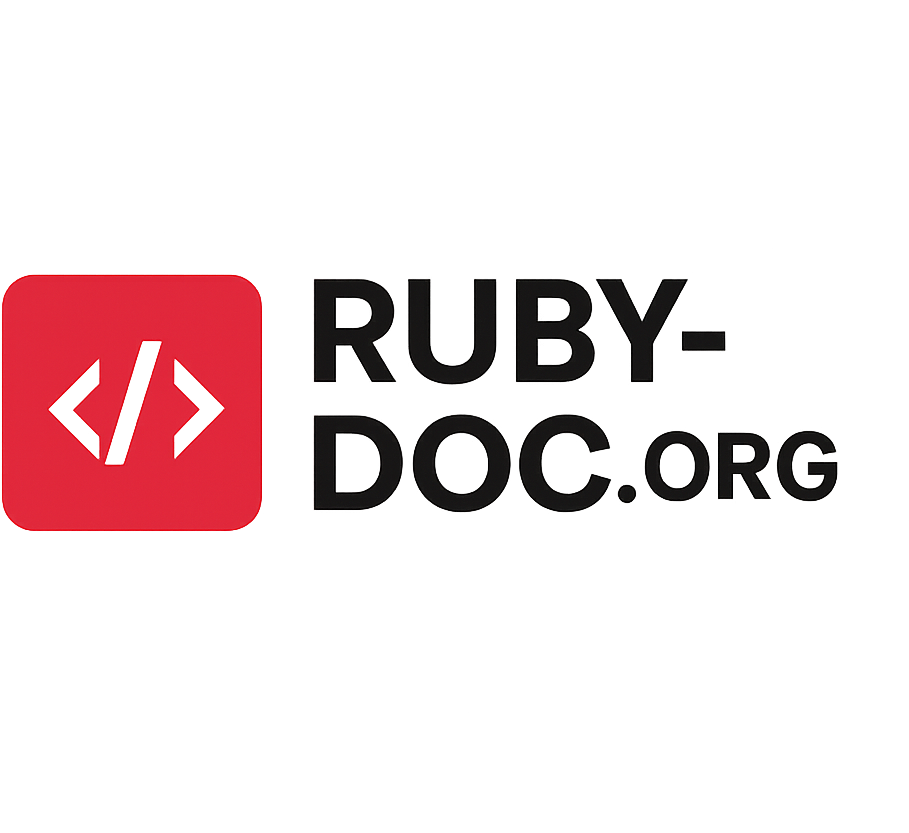
When it comes to choosing the right programming language for your project or team, two names that often arise are Ruby and Go (also known as Golang). Each language has built a strong following, unique advantages, and specific use cases. But how do they stack up against each other? This article dives deep into the Ruby vs Go debate to help you understand their differences, similarities, and when to use one over the other.
Ruby vs Go Table of Contents
- Introduction
- A Brief History
- Syntax and Readability
- Performance
- Concurrency and Parallelism
- Ecosystem and Libraries
- Use Cases
- Learning Curve and Community Support
- Development Speed
- Deployment and DevOps
- Error Handling
- Object-Oriented vs Procedural Paradigm
- Tooling and IDE Support
- Case Studies and Real-World Examples
- Conclusion: Ruby vs Go – Which Should You Choose?
1. Introduction
Both Ruby and Go are modern, high-level programming languages that offer powerful features, but they cater to different kinds of developers and projects. While Ruby is known for its developer-friendly syntax and productivity, Go is praised for its performance and concurrency capabilities.
Understanding the Ruby vs Go comparison is crucial for CTOs, software engineers, and startup founders aiming to make informed tech stack decisions.
2. A Brief History
Ruby
Ruby was created in 1995 by Yukihiro “Matz” Matsumoto, with a goal to make programming more enjoyable for humans. It gained significant traction with the release of the Ruby on Rails web framework in the mid-2000s, which emphasized convention over configuration and rapid application development.
Go
Go, or Golang, was developed at Google in 2007 and released publicly in 2009. Created by Robert Griesemer, Rob Pike, and Ken Thompson, Go was designed to be efficient, statically typed, and scalable—especially for large-scale systems and cloud-native applications.
3. Syntax and Readability
Ruby
Ruby has often been described as beautiful, elegant, and close to natural language. Its expressive syntax allows developers to write clean, readable code with minimal boilerplate.
Example:
rubyCopyEditdef greet(name)
puts "Hello, #{name}!"
end
Go
Go’s syntax is minimalist and pragmatic, closer to C in structure but with a modern twist. It enforces formatting standards (via gofmt) and prioritizes simplicity over cleverness.
Example:
goCopyEditfunc greet(name string) {
fmt.Printf("Hello, %s!\n", name)
}
Winner: Ruby for readability and expressiveness, but Go for enforced consistency.
4. Performance
Ruby
Ruby is an interpreted language, and although efforts like JRuby and TruffleRuby have improved performance, it generally lags behind compiled languages.
Go
Go is compiled into machine code and delivers performance closer to C/C++, making it a great fit for performance-critical applications like APIs, servers, and CLIs.
Winner: Go, hands down, in raw performance.
5. Concurrency and Parallelism
Ruby
Ruby has threads and fibers but is constrained by the Global Interpreter Lock (GIL) in MRI (Matz’s Ruby Interpreter), limiting true parallel execution.
Go
Go was built with concurrency in mind. Its lightweight goroutines and channels allow developers to write concurrent programs with ease.
Example:
goCopyEditgo doSomething()
Winner: Go, especially for systems programming and scalable services.
6. Ecosystem and Libraries
Ruby
Ruby boasts a rich ecosystem, especially in web development thanks to Ruby on Rails. The RubyGems package manager offers tens of thousands of libraries and plugins.
Go
Go’s ecosystem is growing fast, particularly in microservices, networking, and cloud-native apps. While it doesn’t yet match Ruby’s breadth in web development, it shines in infrastructure and tooling.
Winner: Depends on use case
- Web apps: Ruby
- Infrastructure/tools: Go
7. Use Cases – Ruby vs Go
| Use Case | Ruby | Go |
|---|---|---|
| Web Development | ✔️ (Ruby on Rails) | ✔️ (Echo, Gin frameworks) |
| Microservices | ⚠️ (Less common) | ✔️ (Strong support) |
| Command-line tools | ⚠️ | ✔️ |
| Data Processing | ⚠️ | ✔️ |
| Rapid Prototyping | ✔️ | ⚠️ |
Summary: Choose Ruby for quick MVPs and Go for production-scale systems.
8. Learning Curve and Community Support
Ruby
Ruby is beginner-friendly with a supportive community and extensive documentation. Its expressive syntax makes it easier to grasp for non-programmers or those transitioning from other high-level languages.
Go
Go has a steeper initial learning curve, especially for those unfamiliar with static typing or concurrency concepts. However, its documentation is world-class, and the community is growing rapidly.
Winner: Ruby for ease of learning. Go for those coming from C or Java.
9. Development Speed
Ruby’s convention-over-configuration philosophy accelerates development time. Developers can build prototypes or full-stack applications quickly with minimal setup.
Go is more verbose and explicit, which leads to slower initial development but pays off in long-term maintainability and clarity.
Winner: Ruby for speed of development, Go for long-term efficiency.
10. Deployment and DevOps
Ruby
Ruby apps, particularly Rails, can be complex to deploy due to dependencies, environment configuration, and runtime issues.
Go
Go compiles into a single binary, simplifying deployment. Its lack of runtime dependencies and fast startup time make it ideal for containerized environments and CI/CD pipelines.
Winner: Go for DevOps simplicity.
11. Error Handling
Ruby
Ruby uses exceptions, which can sometimes obscure the flow of control. While concise, it can also lead to bugs if not handled carefully.
Go
Go uses explicit error handling via return values. Although more verbose, it forces developers to address errors systematically.
Example:
goCopyEditresult, err := doSomething()
if err != nil {
log.Fatal(err)
}
Winner: Go, for reliability. Ruby is simpler but can be more error-prone.
12. Object-Oriented vs Procedural Paradigm
Ruby is purely object-oriented—even primitive types are objects. This makes it a great fit for domains where modeling behavior and relationships matter.
Go follows a procedural + structural paradigm, focusing on simplicity and composition over inheritance.
Winner: Subjective
- Use Ruby for domain-driven design.
- Use Go for composable and scalable systems.
13. Tooling and IDE Support
Ruby
Popular editors like VS Code and RubyMine offer good support, but the Ruby ecosystem can be fragmented with tooling.
Go
Go ships with excellent built-in tools (gofmt, go build, go test, etc.). IDEs like GoLand, VS Code, and LiteIDE offer top-notch support.
Winner: Go, for out-of-the-box tooling.
14. Case Studies and Real-World Examples
Ruby in Action
- GitHub: Originally built with Ruby on Rails
- Shopify: One of the largest Rails apps ever built
- Basecamp: The creators of Rails
Ruby is the backbone of many SaaS products, thanks to its productivity.
Go in Action
- Docker: Written in Go
- Kubernetes: Core components written in Go
- Terraform: HashiCorp’s infrastructure-as-code tool is built with Go
Go dominates in cloud-native infrastructure, DevOps tooling, and performance-critical applications.
15. Ruby vs Go – Which Should You Choose?
Ultimately, the Ruby vs Go decision comes down to your project requirements, team experience, and long-term goals. Here’s a breakdown:
| Criteria | Best Language |
|---|---|
| Rapid prototyping | Ruby |
| Web development (MVP) | Ruby |
| Web development (scale) | Go |
| Performance-critical apps | Go |
| Infrastructure/tools | Go |
| Developer experience | Ruby |
| Concurrency | Go |
| Maintainability | Go |
| Learning for beginners | Ruby |
Final Thoughts
- Choose Ruby if you’re building a startup MVP, want to iterate quickly, and prioritize developer happiness.
- Choose Go if you’re building scalable, concurrent systems with an eye toward performance and long-term maintainability.
While the Ruby vs Go debate will likely continue, it’s not a matter of one language being better than the other—they simply solve different problems. A savvy developer or tech lead will understand when to use each.
In fact, many organizations successfully use both: Ruby for frontend-facing applications and Go for backend services or infrastructure. Embracing the strengths of each can result in a tech stack that’s both agile and robust.
Read about Ruby vs Python, and Ruby vs Ruby on Rails in our other comparison articles.
